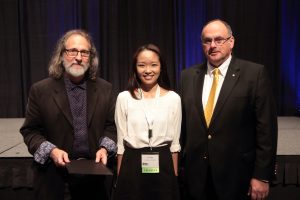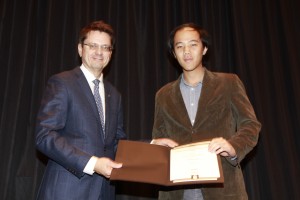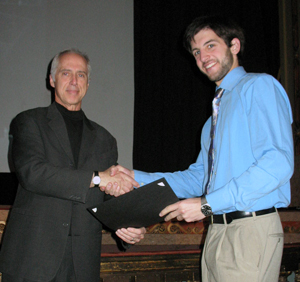The AIA Virginia Prize Archive
About the Prize
Students from Hampton University, Virginia Tech, The Washington-Alexandria Architecture Center, the University of Virginia, and James Madison University are eligible for this competition. Held annually near the start of the school year, students spend the weekend designing a response to a problem created by faculty from one of Virginia’s architecture schools. Each school’s faculty reviews the submissions and sends up to 10 finalists to Richmond for final judging.
2024 AIA Virginia Prize
The brief from Hampton University invited students to design a “bookless” public library as a community public room on a corner site at the intersection of N. Mallory Street and E. County Street in Phoebus, Virginia.
See the winners of the 2024 prize challenge
2023 AIA Virginia Prize
UVa challenged students to design a house for two artists that will include their workshop and a public program in the form of an exhibition space and an educational space.
See the winners of the 2023 prize challenge
2022 AIA Virginia Prize
Craft an architectural proposition in the form of a passenger rail station to serve Virginia’s New River Valley (NRV). Download the complete Competition Brief and Challenge.
Resources
Amtrak Station Program and Planning Guidelines
See the winners of the 2022 Prize challenge.
2021 AIA Virginia Prize
Background
The 2021 prompt is inspired by the Equal Justice Initiative’s Community Remembrance Project:
The Equal Justice Initiative (EJI) is a private, nonprofit organization that challenges poverty and racial injustice, advocates for equal treatment in the criminal justice system, and creates hope for marginalized communities. EJI opened The Legacy Museum: From Enslavement to Mass Incarceration and National Memorial for Peace and Justice in Montgomery, Alabama in 2019.
The National Memorial for Peace and Justice includes over 800 steel monuments, or pillars, one for each county in the United States where a racial terror lynching took place, with the names of the lynching victims engraved on the pillars. A field of identical monuments is in a park adjacent to the memorial. EJI’s Community Remembrance Project invites counties across the country to claim their monuments and install them in the counties they represent. In addition to installing the pillars, EJI encourages participating communities to place a historical marker and to collect soil from the site of the lynchings, to “allow communities to gain perspective and experience that we believe is crucial to managing the monument retrieval process wisely and effectively.”
Competition Challenge
Design a pillar installation for the City of Alexandria’s Market Square. Background, site plans and photos are provided.
Download the Competition Brief and Challenge
See the winners of the 2021 Prize.
The 2020 AIA Virginia Prize Competition
The competition — which took place over the weekend of Jan. 24–27 — challenged students to design a small oyster research hatchery [Read the full competition brief.]
See the 2020 honorees.
The 2019 AIA Virginia Prize Competition
Students convened on Friday, Jan. 25, 2019 to begin the competition.
The brief challenged students to design a Pop-Up Café:
What is it about cheap food, long hours, and counters that so consistently captures the American imagination?
“First I ate a breakfast, a modest one of toast and coffee and one egg, and I cut out of town to the highway.” (On the Road, 1957, Jack Kerouac)
Program:
“The diner is everybody’s kitchen.” (Richard Gutman)
a pop-up diner/café
small kitchen and short-term supply storage
dining counter for standing and sitting customers
a mobile diner/café allows one to set up a food service business quickly using pre-assembled constructs and equipment.
consider the energy, water and waste flows
Site:
Parking lot, alley, warehouse, roof-top, etc. in the vicinity of your school.
See the 2019 honorees.
The 2017 AIA Virginia Prize Competition
Students convened on Friday, September 15 to begin the competition.
The competition brief was to design a terminus for King Street at the Potomac River waterfront to celebrate its historic role as the origin of Alexandria and the front door of the City. The design solution was required to be a significant public space that offers a destination, or as was written: “where one of America’s great streets meets one of America’s great rivers.” It also had to provide a counterpoint to the George Washington Masonic National Memorial at the other end of King Street. The open space was required to include access to a dock for water taxis, which took commuters and tourists to points of interest in Washington DC and Maryland. A building at the terminus had to be designed to include the programmatic spaces of a ticket office, public toilets, waiting area, coffee and snack service and an exhibit area for local historic information and small archaeological objects. The 2017 Prize was sponsored by Moseley Architects.
Erik Styrbjorn Odd Torell from Virginia Tech was the recipient of the 2017 AIA Virginia Prize. Read more>>
The 2016 AIA Virginia Prize Competition
At 5 p.m. Friday, Sept. 16, students at the University of Virginia, Virginia Tech, The Washington-Alexandria Architecture Center (WAAC), and Hampton University were given a limited time challenge. By 9 a.m. Monday participating students had to turn in their designs for a new space that would bring forward the histories of the First Africans in Virginia for a historical marker of the same name near Fort Monroe. The space proposed would be for contemplation, congregation, participation, celebration and performance. Please find the 2016 AIA Virginia Prize Brief and Supplemental materials here.
“The point was to create a space that would help us better understand today those Africans brought here almost 400 years ago,” says Jury Chair, Charles Swartz, AIA, Principal at Reader & Swartz Architects in Winchester, Virginia. “Faculty from each school did the first judging and sent the top 10 submissions to Richmond for the final round. A four judge panel selected one Prize winner, four best of school awards, two certificate of merits and six notables.”
The Honorees

Xi Han is the winner of the 2016 AIA Virginia Prize which includes a $1,500 cash prize. Han is in her final year at the University of Virginia, planning to graduate in 2017.
The judges were impressed with the way she tells the story of the first Africans in Virginia. “The design did a very good job connecting to the journey, the water and the existing structures. The way that the site would change depending on the weather, time of year and time of day, would make it a destination for travelers to see multiple times.”
Best of School
Iroda Karimova expects to graduate with a Masters in Architecture from Hampton University in 2017.
John Hatcher expects to graduate from the University of Virginia in 2018.
Divya Nautiyal expects to graduate with a Masters in Architecture from Virginia Tech in 2017.
Ian Hunter expects to graduate with a Masters in Landscape Architecture from The Washington-Alexandria Architecture Center in 2017.
Certificate of Merit
M. Ryan Delaney, The Washington-Alexandria Architecture Center
Carlin Tacey, The Washington-Alexandria Architecture Center
Notable
Luke Dale, Virginia Tech
Dennis Daniels, The Washington-Alexandria Architecture Center
Rachel Flanagan, Virginia Tech
Philippa Koenig, The Washington-Alexandria Architecture Center
Qian Li, Virginia Tech
Julian Lin, The Washington-Alexandria Architecture Center
The 2015 AIA Virginia Prize Competition
On Friday, September 11, at 5 p.m., over 300 students from Hampton University, Virginia Tech-Blacksburg, Virginia Tech-Washington Alexandria Architecture Center and the University of Virginia were given a challenge to design a response to a problem created by faculty from one of Virginia’s architecture schools. They had one weekend to consider as a work of art, the design of the Rocky Forge Wind Farm, now being developed in Botetourt County. They were told their submissions should not only meet the pragmatic demands of the turbine array, but also engage the inherent aesthetic potential in a large-scale human intervention within the natural landscape.
“Faculty from each school reviewed the submissions and sent their top 10 for final judging,” says AIA Virginia Executive Vice President/CEO Helene Combs Dreiling, FAIA. “From these, a four-judge panel selected one Prize winner, four best of school awards and five honorable mentions.
The Winner

Tommy Kim is now in his final year of a five-year program at Virginia Tech-Blacksburg. Kim, who came to Virginia Tech following graduation from Stone Bridge High School in Ashburn, Va., spent one year of his architecture program at the university’s Washington-Alexandria Architecture Center.
The judges were most complimentary. “The building is almost completely hidden which adds to the intriguing experience,” says Jury Chair Jim Clark, FAIA. “The consistency in design and the sequence of events is very strong. Loved the vista image, especially how it balances the plan. Enjoyed that it was unique to the location.”
Best of School
Vaughn James, now in his last year at Hampton University
Lauren Scott, in her senior year at University of Virginia
Forrest Bibeau, in his final year at Virginia Tech, Blacksburg
Matthew Duncan, a graduate student at Virginia Tech-Washington Alexandria Architecture Center
Honorable Mention
Matthew Young, Virginia Tech
James Wood, Virginia Tech
Zeph Ruggles, University of Virginia
Seema Samudre, Virginia Tech
Min Hyoung Choe, Virginia Tech
The 2013 VSAIA Prize Competition
The 2013 VSAIA Prize Competition was held over the weekend of February 1-4. This year’s competition has a new partner and Corporate Sponsor, the Virginia Housing Development Authority, who collaborated with faculty from Virginia Tech’s Washington Alexandria Architecture Center to develop the competition program brief.
Students in Virginia’s architecture schools were given the program Friday at 5:00 pm. The students worked over the weekend to create a board presenting their design solution by 9:00 am Monday morning.
The 2013 Prize program is for a mixed-use fire station combined with dwelling units for the Beauregard neighborhood in Alexandria. From the program:
The building should consider the well-being of the community, enhancing a sense of place by designing this mixed use building for dwelling and fire protection. Mixed-use/mixed-income developments are important in the revitalization of older communities, complementing existing communities, traditionally designed in proximity of housing to goods, services, transportation and jobs. Giving new life to older communities such as Beauregard will come about by introducing new dwellings and protections (such as a fire station) to these communities. In this design competition you are asked to consider the powerful qualities of both fire and dwelling as you devise a design that reaches beyond pragmatic and efficient means. Your design should emphasize the power of home and fire while creating a potential for happiness, comfort, and security within this new community
Faculty from the schools (Hampton University, Virginia Tech WAAC, Virginia Tech Blacksburg, and the University of Virginia) reviewed all the submitted boards and selected ten finalists from each school to send to VSAIA. The jury, chaired by Mary Patton Cox, FAIA, met in April to select the 2013 VSAIA Prize winner as well as Best of School boards from each of the remaining schools.
The 2013 VSAIA Prize Winner is Robert Lingo of Virginia Tech. The Jury’s comments:
We liked the way this entry takes the program from the abstract to the real, all in one board. We liked the use of the foundry, combining a positive use of fire with a firefighting facility. We also liked the varying scales, both macro and micro. This entrant clearly thought beyond the scope of the problem, incorporating a community outreach component, into their solution. The board is also a nicely designed composition. Anyone can understand the presentation techniques.
Best of School WAAC – Liz M. Fibleuil
We liked the bold expression of fire, and the bold strokes of the presentation. The entry takes an intangible and gives it three dimensional expression in the forms and floor plan. The use of color in the board is very vivid, as is the use of text in the descriptions of the design concepts. The concept was conveyed well and well executed; we understood what they were trying to say.
Best of School Hampton University – Alvin L. Mendoza
This was a project that truly integrates the sense of community into the complex. Not a traditional fire station per se, but that is partly what makes it remarkable. An iconic structure which is tied into the community and integrates the programmatic elements. We liked the lyrical illustration of licks of flame, which is a creative interpretation.
Honorable Mention – Kevin Gerrity, Virginia Tech
We understand that this is not really a practical solution, but we liked the strong conceptual design, especially the components that can be plugged in as needed… very adaptable! The design of the board is lovely, very striking. The Imagery is quite alluring, it draws you to it. Even the text box lines up with the residential floor plans. The section and floor plans describe it very well. A strong idea.
VSAIA extends a special thank you to the Virginia Housing Development Authority, and congratulations to all who participated!
2012
The 2012 VSAIA Prize Competition was held the weekend of January 27-30, 2012. The competition brief, designed by faculty at Hampton University, was to design multi-use storm shelter for the Outer Banks of North Carolina.
The jury was comprised of Paula Loomis FAIA (chair), Andrea Quilici AIA, Kurt Keesecker AIA, Mike Stoneking, and John Diven.
The winner of the 2012 Virginia Society AIA Prize was Eric Kuhn of the University of Virginia.
Other Honorees:
Best of School Hampton University, Carlton Copeland
Best of School Virginia Tech WAAC, Ningning Shang
Best of School Virginia Tech Blacksburg, John Jennings
Honorable Mention, “Kit Award”, Meagan McFadden, University of Virginia
Honorable Mention, Creativity, Zack Saunders, Virginia Tech Blacksburg
Notable, “Stanley Kubrick Award”, Chris Yetka, Virginia Tech Blacksburg
Notable, Ingenuity, Harsh Vardhan Jain, University of Virginia
Read the jury comments about all the honored boards.
The $2000 Prize and certificate was awarded at Virginia Design Forum, March 17, in Charlottesville.

2011
The 2011 Virginia Society AIA Prize Competition was held January 29-30, 2011.
The program was designed by faculty at Virginia Tech.
The 2011 VSAIA Prize Competition Problem may be found here.
The jurors for 2011 were Timm Jamieson FAIA, Michel Ashe FAIA, Joe Atkins AIA, and Steve McCurdy.
Learn about the honorees and read the the jury comments here.
2010
The 2010 competition problem was designed by faculty at the University of Virginia School of Architecture.
The competition was held the weekend of Jan. 29, 2010
The competition problem may be found here.

The 2010 VSAIA Prize was awarded to Harry Rosenbaum, of Virginia Tech Blacksburg.
Best of School Hampton University
Mark Paulo Ramos Matel
Best of School Virginia Tech WAAC
Jacob Linn
Honorable Mention recognition went to:
Emilia A. Baker, Virginia Tech Blacksburg
Shane Dunlevy, Virginia Tech WAAC
See a summary of the Prize problem and the winning work here.
Contact Wayne Conners at (804) 644-3041, ext. 303, for additional information on these programs.
